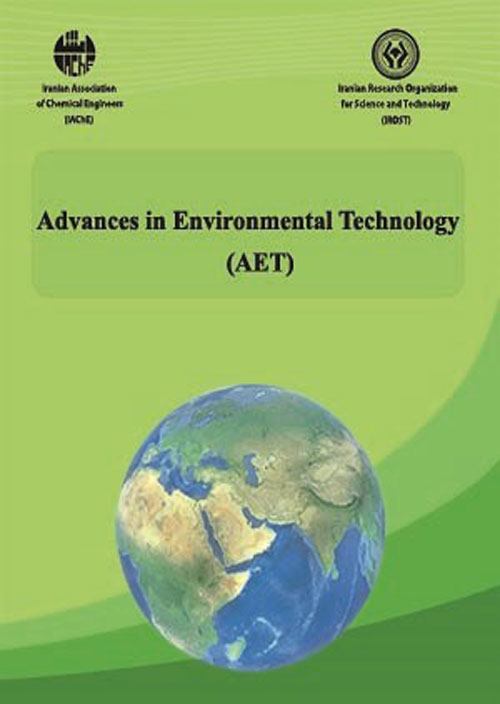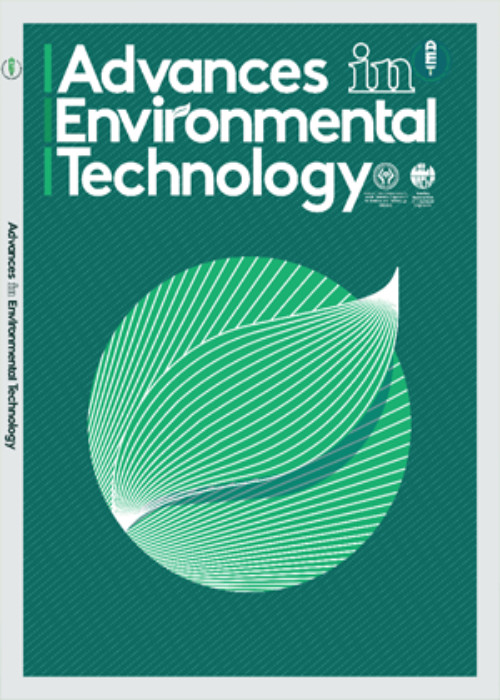فهرست مطالب

Advances in Environmental Technology
Volume:5 Issue: 3, Summer 2019
- تاریخ انتشار: 1399/06/12
- تعداد عناوین: 6
-
-
Pages 133-140
Maintaining the levels of nitrogen in agricultural fields to ensure crop yield performance is challenging due to the complex dynamics of nitrogen transformation in soil. Nitrogen is mainly taken up by plant roots in the form of nitrate, but it is considered as an environmental pollutant that threatens human and animal health. Therefore, it is necessary to use adsorbent compounds to retain nitrate in the soil. The effectiveness of two types of biochar produced from rice husk (Br) and populous wood (Bp) and two arbuscular mycorrhizal fungi, namely Funneliformis intraradices (Mi) and Funneliformis versiforme (Mv), on nitrate leaching in soil was evaluated. The soil columns planted with corn were filled with an artificial sandy clay loam soil fertigated with urea fertilizer under glasshouse conditions . After nine weeks of growing the plants, a pulse of nitrogen (0.48 g urea per core) was added to the columns. One week after the addition of urea, the shoots of the plants were removed, and the columns immediately flushed with 500 ml of deionized water to leach the soil nitrogen from the columns. The results showed that the shoots' dry-weight increased significantly (p≤ 0.05) in almost all the treatments with the highest in the BrMi treatment when compared to the control (C). The nitrate concentration in the leachate decreased 79% (from 23.2 mg/l in C treatment to 4.2 mg/l in Bp treatment), but the nitrate concentration in the soil solution increased up to 6.7-fold (Bp was the highest), which suggested a high N retention by the biochars used. It was concluded that the application of biochar and mycorrhizal fungi could reduce nitrogen loss through this artificial sandy clay loam soil and may have some implications in environment conservation.
Keywords: Biochar, Fertilizer, Nitrate leaching, Mycorrhizae -
Pages 141-148Forward osmosis (FO) is an energy-saving separation process that can be used in desalination applications. This work investigated the effect of mass transfer phenomenon on the FO desalination process. For this purpose, the water flux was studied through a bench scale system using a flat sheet FO membrane and feeds with various salinity. Then, the mass transfer resistances, which appear in the form of concentration polarization (CP) for the FO process, were evaluated qualitatively and quantitatively, using the collected experimental data and by employing a mathematical model. The results indicated that the increase in feed salinity led to a decrease in water flux due to the counteracted part of the draw solution osmotic pressure, thus leading to a lower effective osmotic pressure and driving force. Also, according to the results, there was a significant difference between the theoretical and experimental fluxes, indicating the influence of the mass transfer effects on the osmotic pressure drop. The modeling results showed that the internal concentration polarization (ICP) still held more contribution to the osmotic pressure loss. Furthermore, it was observed that as the feed solution concentration increased, both the ICP and dilutive external concentration polarization (DECP) decreased, whereas the concentrative ECP (CECP) intensified. Therefore, increasing the CECP led to a significant reduction in the effective osmotic pressure. In addition, increasing the draw solution concentration was accompanied by a much more severe ICP that limited the enhancement of effective flux.Keywords: Forward Osmosis (FO), Brine wastewater, concentration polarization, Mass transfer
-
Pages 149-156Application of nanotechnology has gained remarkable interest in recent years and environmental exposure to nanomaterials is becoming inevitable. Therefore, nanotoxicity problem is gaining more attention. Zero-valent iron nano particles (nZVI) are being used widely for different purposes such as environmental remediation. Excessive amounts of nanomaterials may pose inhibitory effects on growth of plants cultivated in nZVI-affected soils which has been addressed in this research. Moreover, fate of nZVI in plants was investigated in the present study. Plant seeds were exposed to different concentrations of nZVI i.e. 0, 100, 250, 500, 800 and 1000 mg/kg. Z. mays was selected as the model plant in this study and found to be a tolerant plant species in presence of low to moderate levels of nZVI in soil. However, addition of higher doses of nZVI reduced seedling emergence and biomass establishment. Results indicated that the total Fe concentrations in Z. mays treated with nZVI increased compared to the control. Considerably higher accumulation of Fe in roots of Z. mays compared to the shoots in all treatments was found. Results indicated that the total Fe contents in Z. mays treated with nZVI were higher than those in control, with the highest Fe accumulation capacity of 24666.2 µg per pot which was obtained in soil received 500 mg/kg nZVI. Overally, toxic effects of higher doses of nZVI on plants were observed in this study. Intelligent use of nZVI for environmental purposes such as applying low to moderate levels of nZVI in soil remediation activities could remarkably prevent their adverse impacts on plant species, promote plant phytoextraction capability, and reduce nZV emission in the environment.Keywords: Zero-valent iron nanoparticles, toxicity, Z. mays, plant growth, phytoextraction
-
Pages 157-169In this study, a synthetic and modified PPAP-MPTMS-MCM-41 nano-adsorbent was used to remove nickel (II) during a batch process. Studying the parameters that were effective on adsorption revealed that the PPAP-MPTMS-MCM-41 adsorbent was the most effective in the adsorption of nickel (II) from a standard solution (Conc. = 5 mg/L, volume = 100 mL) under the following conditions: pH=8, contact time = 20 min, 6 wt.% of poly para-aminophenol (PPAP) ligand, adsorbent mass = 0.3 g, 1 molar hydrochloric acid (to remove nickel from the adsorbent), and NaCl salt with a concentration of less than 100 g/L. The results showed that the Langmuir isotherm had a higher linear and non-linear fitting with the experimental data. Investigating the kinetic models and mass transfer of this adsorption process showed that the experimental data were in good agreement with the pseudo-second-order kinetic model and the intra-particle mass transfer model. According to thermodynamic studies, this adsorption process is endothermic; its Gibbs free energy value is positive such that with an increase in temperature, it goes to lower values, and thus the process progresses spontaneously.Keywords: Mesoporous MCM-41, Nano-adsorbent, Isotherm, Nickel
-
Pages 171-183
Water is a key factor in our lives, yet this valuable asset is progressively under threat. From the total share of the Earth's water, only 2% is fresh water, which is available for various life forms, including humans. Monitoring the quality of water is very important to check the physical, chemical, and biological characteristics, and the subsequent control of its wholesomeness. Particularly, the estuarine water bodies that are rich in diversity confront more threats for contamination in the entire riverine framework. This study was carried out to evaluate the current status of various physico-chemical properties of four different estuarine locations of the Gahirmatha coast, in the Indian state of Odisha in the eastern part of the Bay of Bengal: water temperature, pH, conductivity, TDS, TSS, turbidity, salinity, DO, BOD, total alkalinity, fluoride, Nitrite-N, Ammonia-N, Nitrate-N, phosphate, silicate, total chlorophyll. The study was carried out during the pre-monsoon (March to April) and post-monsoon (November to December) seasons in 2019. The surface water samples were collected from designated stations both during low tide and high tide to observe tidal influence. The data were subjected to statistical analysis regarding correlation coefficient, principal component analysis (PCA), and cluster analysis (CA) for interpretation. The Pearson correlation showed that the results were significantly correlated both at the 0.05 and 0.01 level of significance. When PCA was interpolated for the pre-monsoon and post-monsoon data, three broad groups were categorized. The highest eigen value was about 10.87 during the pre-monsoon and 9.07 during the post-monsoon season, and the cluster analysis showed there were two major groups of parameters with respect to the Euclidean distance. The observed variations in the concentration of these physico-chemical parameters in the estuarine waters of the Gahirmatha may be attributed to the riverine inputs from the catchment of rivers like the Brahmani, Baitarani, and Dhamra, which are associated with anthropogenic local activities.
Keywords: Estuarine water body, Gahirmatha coast, Physico-chemical parameters, Statistical techniques, East coast of Bay of Bengal -
Pages 185-191
In this study, spatial zoning models were compared to evaluate the concentrations of PM 2.5 on a large scale in the urban landscape of Tehran. The spatial analysis of PM 2.5 concentration was conducted based on the data from twenty-four stations that measure and monitor the air in Tehran. Three interpolation models were used to assess the air pollution status via Arc GIS 10.6.1 software: universal kriging (UK), ordinary kriging (OK), and inverse distance weighted (IDW). The root mean square error (RMSE) and correlation coefficient (R2) were applied to compare the spatial models and select the best model. Standardized root-mean-square error (RMSE) was used to select the best conditions for running the OK and UK models. The results showed that the southern and central regions of Tehran had high concentrations of PM 2.5, and the annual mean of all the stations exceeded the EPA standard (15 μ/m3). According to the annual average, station 16 had the highest concentration of PM2.5 (112.75 μ/m3). The results of RMSE showed that the OK model was more suitable than the others for the spatial zoning of air pollution in the urban landscape (RMSE=9.322).
Keywords: Air pollution, Spatial zoning, Interpolation models, Tehran, PM 2.5


